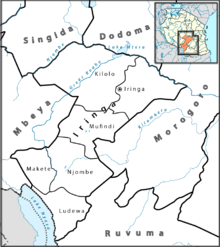Makete
Makete (sometimes also spelled 'Mwakete') is one of four districts of the Njombe region founded on March 1, 2012 in the south-western part of Tanzania . Makete is divided into 23 districts (wards) with a total of 93 localities. The census of 2012 (2002) showed a population of 97,266 (106,061) inhabitants, of which in 2002 45.8 percent were male and 54.2 percent female. Makete borders Njombe Town to the east, Ludewa to the south, and the Mbeya region to the west and north .
The area of the district is 5800 km², of which only 371 km² can be used for agriculture . The country is at an altitude of 1,500 to 3,000 meters above sea level and is traversed by both the Livingstone Mountains and the chain of Kipengere Mountains . The temperatures are between 2 and 20 ° C on the mountains and between 20 and 30 ° C on the plateau, the annual precipitation is between 1500 and 2800 mm in the mountains and 300 to 800 mm on the plateau. Important rivers coming from the mountains are Numbi , Kimani , Luvanyila and Ijangala .
Social situation
The greatest administrative challenges to be overcome at the moment are a better transport infrastructure and better health care. HIV / AIDS poses a particular challenge in the region. The number of people who tested positive for HIV increased from 3,900 in 1988 to over 10,000 in 2002. In particular, caring for orphaned children makes up a large part of the expenses. A Mama Mkubwa program funded by UNICEF offers financial support for this. Almost five percent of children up to the age of 17 are orphans. A large number of non-governmental organizations (NGOs) and faith-based organizations ( FBO in English) particularly emphasize the fight against undernourishment and malnutrition in their work.
economy
Agriculture is an essential part of the livelihood of most of the people in the Makete district. Because of the moderate temperatures due to the altitude, mainly wheat and potatoes are grown; also you can see pumpkin , Phaseolus - beans and peas widely used in the batch cultivation. Likewise, climatically adapted fruit trees such as plums, peaches, apples and pears are widespread. The area is also known for its bamboo wine ( ulanzi ), which is made from the fermented juice of the wine bamboo ( Oxytenanthera braunii ). Traditionally, the men from the Makete district hire themselves out as pickers on the country's tea plantations. Corn was only recently introduced into the area. Various pets are kept, with cattle mostly grazing on communal pastures, while goats, pigs and chickens are kept closer to the house. In the majority of rural households, guinea pigs ( Cavia porcellus ) are kept as meat animals, but they hardly appear in official statistics. The animals are locally called simbilisi , a kihehe word. The leaves of the wine bamboo are usually fed to guinea pigs in Makete.
Districts (Wards)
Administratively, the Makete district is divided into the following 22 districts (wards):
- Bulongwa
- Ikuwo
- Iniho
- Ipelele
- Ipepo
- Isapulano
- Itundu
- Iwawa
- Kigala
- Kigulu
- Kipagalo
- Kitulo
- Lupalilo
- Lupila
- Luwumbu
- Mang'oto
- Matamba
- Mbalatse
- Mfumbi
- Mlondwe
- Tandala
- Ukwama
literature
- Ruth Evans: We are managing our own lives…: Life transitions and care in sibling ‐ headed households affected by AIDS in Tanzania and Uganda . In: Area . tape 43 , no. 4 , 2011, p. 384-396 , doi : 10.1111 / j.1475-4762.2010.00954.x .
Web links
- Makete District Homepage for the 2002 Tanzania National Census
- Kasumba, FO 2005. Child Headed Households in Tanzania: A Case of Makete District.
- Lucas et al. 1995. The Njombe-Makete Road: An Impact Assessment of an ATAP Funded Road Improvement Project. (PDF file; 2.17 MB)
- Mkasafari Mlay. 2000. Migrants with HIV / AIDS: A challenge to the media in Tanzania. In: Kwame Boafo, ST (ed.) In collaboration with Arnaldo, CA Media & HIV / AIDS in East and Southern Africa: A resource book. UNESCO, Paris, France.
Individual evidence
- ↑ Mwanzo. Retrieved February 22, 2020 (English).
- ^ Tanzania Regional Profiles, 22 Njombe Regional Profiles. The United Republic of Tanzania, 2016, accessed February 22, 2020 .
- ↑ IRINGA MUNICIPAL PROFILE INTRODUCTION ( Memento of March 27, 2009 in the Internet Archive )
- ↑ http://www.ourmakete.org/index.html ( page no longer available , search in web archives ) Info: The link was automatically marked as defective. Please check the link according to the instructions and then remove this notice.
- ↑ Archived copy ( memento of the original from March 15, 2012 in the Internet Archive ) Info: The archive link was inserted automatically and has not yet been checked. Please check the original and archive link according to the instructions and then remove this notice.
- ↑ http://publications.ossrea.net/index.php?option=com_sobi2&sobi2Task=sobi2Details&sobi2Id=512&Itemid=0
- ↑ http://www.unesco.org/webworld/publications/media_aids/chapter_6.pdf
- ↑ http://www.unicef.org/infobycountry/files/Tanzania_Mama_Mkubwa.pdf
- ↑ http://www.ourmakete.org/index.html ( page no longer available , search in web archives ) Info: The link was automatically marked as defective. Please check the link according to the instructions and then remove this notice.
- Jump up ↑ Wayne P. Armstrong: Bamboo: Remarkable Giant Grasses. In: Wayne's Word. Retrieved July 12, 2020 .
- ↑ http://www.meinerundewelt.at/tag/meerschweinchen/
- ↑ Tanzania National Bureau of Statistics: 2012 PHC: Shapefiles - Level three. Tanzania National Bureau of Statistics, January 1, 2012, accessed June 20, 2020 .

